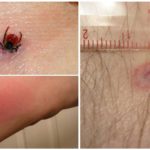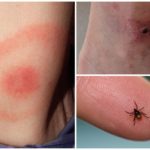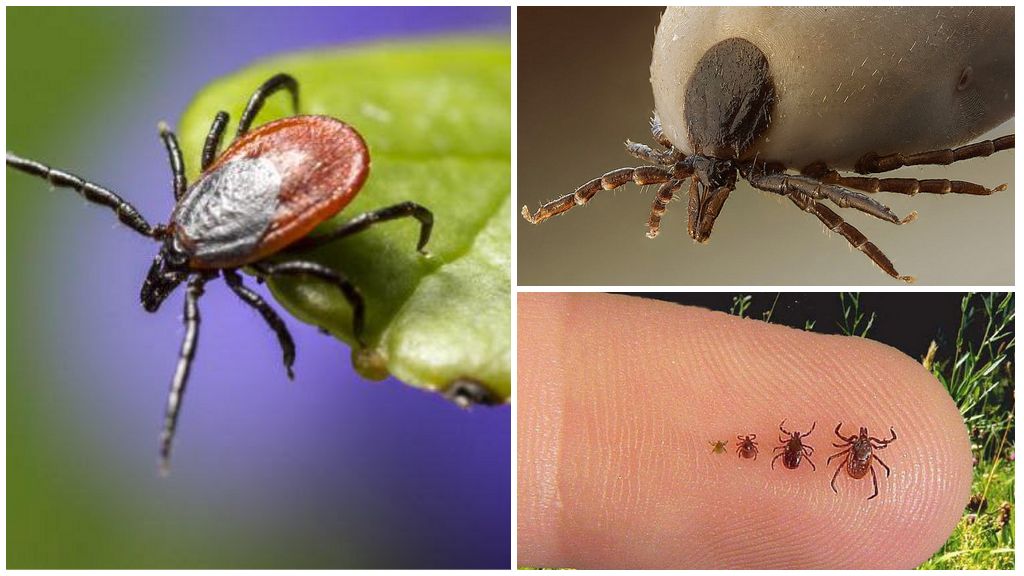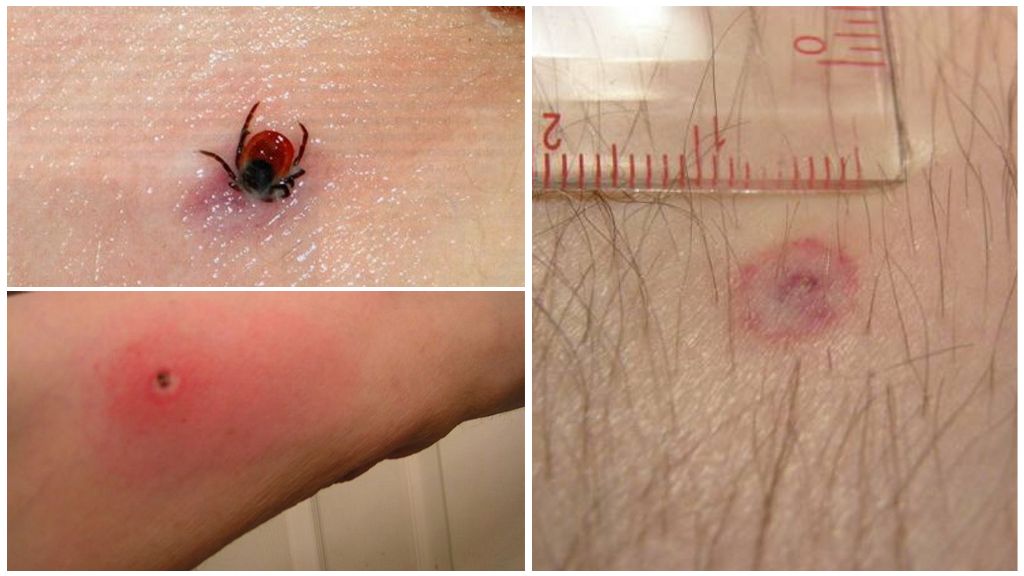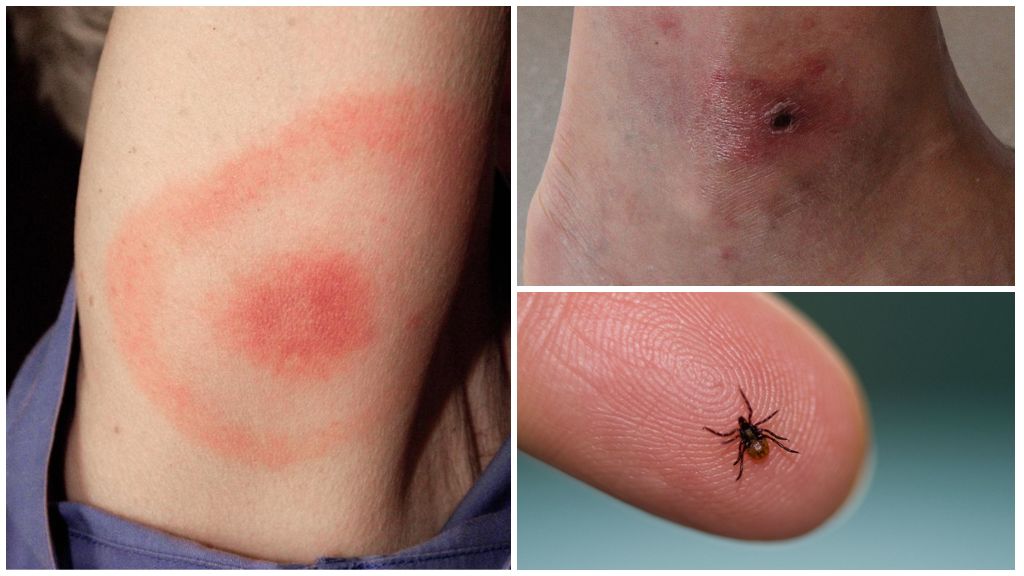Symptoms and treatment of an encephalitic tick bite in humans
Content
- Encephalitis mites
- Bite encephalitis tick on the human body
- Bite encephalitis tick
- Symptoms of tick-borne encephalitis
- Types of tick-borne encephalitis
- Tick-borne encephalitis treatment
With the onset of warm summer days, many seek to spend time outside the bustling city - in the woods or by the river.If you are going with your family and friends on a picnic, you should not neglect the dangers posed by ticks. Observance of precautionary measures, continuous inspection of clothes, bodies will allow to identify the parasite in a timely manner. These tiny representatives of the fauna are carriers of a dangerous, insidious disease called tick-borne encephalitis.
Important!
It is impossible to distinguish a tick visually infected with encephalitis from a sterile parasite. To establish the degree of danger from the bite will allow clinical laboratory research, which can be conducted in Moscow or another village.
Let us consider in more detail what the disease is, as well as the symptoms and treatment of tick-borne encephalitis.
Pliers
These creatures look like insects, but they do not belong to them. Ticks, spiders and scorpions are allocated in a separate class of arthropods - a family of arachnids. The main difference arachnids - the number of legs, which they have 4 pairs. Mite encephalitis in length reaches no more than 3-4 mm.
On a note!
Activity of parasites begins in early April, and by mid-May reaches peak levels.By this time, their number has increased millions of times and the epidemiological threshold of incidence sharply goes up.
With the onset of the mating season (mid-May), the female ixodid ticks, after drinking of blood, begin to lay eggs. After a month, the larvae appear from them, which immediately begin to bite, infecting their victims with a dangerous virus. The period of life of an adult encephalitis tick is approximately 3-4 months. Some representatives of the parasites can be found in late October. About 650 species of ticks belong to the Ixodes. In Russia, the tick-borne encephalitis virus is spread by two types of arthropods - the taiga and dog individuals. They parasitize not only domestic animals - goats, sheep, cows, dogs, and other mammals, which become carriers of a dangerous viral infection.
In nature, encephalitis mites live at a distance of no more than 0.5 meters from the ground. They choose an object by smell, since they have no organs of vision. They cling to clothes or human skin very tightly with the help of special hooks located on the legs.From above on the victim encephalitis ticks fall extremely rarely.
On a note!
After the victim is saturated with blood, the tick's body significantly increases in size and can reach 3 cm.
The science of epidemiology relates tick-borne encephalitis to natural focal diseases that occur in certain areas, with a humid climate favorable for the vital activity of animals and an abundance of animals for food. The main habitat of encephalitic ticks is Siberia, the Urals, the Far East, China and Mongolia. However, disease outbreaks are quite often recorded in forest regions of Eastern Europe and Scandinavia.
What is dangerous encephalitis tick
Quite often, as a result of a tick bite, a person develops encephalitis - an inflammation of the brain, the etiology of which is different. By affecting the central nervous system, the virus can lead to paralysis, mental disorders or even death. At the site of bites, people may experience swelling and a limited area of inflammation. An encephalitic tick rather meticulously searches for a place where you can dig into the skin. The bite of a bloodsucker is dangerous because it:
- absolutely painless;
- several individuals can cling to a person at once;
- most often, the parasite is found on the body only in a few days, when it significantly increased in size, sucking blood.
It is rather difficult to remove the attached tick, therefore this procedure is recommended to be performed in the clinic or in another medical institution. Favorite places on the human body are such areas:
- axillary and popliteal hollows;
- groin;
- neck and ear area;
- scalp;
- loin;
- folds in the abdomen.
These areas have a thin skin and are rich in blood vessels. At the site of arthropod suction, a focus of inflammation develops, which is accompanied by pain and redness, as is seen in the photo of an encephalitis tick bite on a human body.
Important!
The body's response to the presence of a virus in it depends on the state of the human immune system, as well as on the proximity of the parasite to the brain.
After an encephalitic tick has firmly settled on the skin, the infection with the bloodstream quickly spreads and reaches the brain.The severity of the disease and its shape depends on the amount of virus in the body, the number of bites, the geographical affiliation of the parasite. The most severe forms of the disease are recorded after the attack of taiga encephalitis ticks. Fatalities occur in 20-40% of cases, as evidenced by statistics.
Emergency measures when biting
First aid in detecting a sucked mite on the human body is to remove the parasite. All manipulations must be done carefully so as not to tear the proboscis, which is deep in the skin. Their sequence can be represented as follows:
- As close as possible to the skin surface, grab the parasite with tweezers, a loop of thread, or simply with your fingers wrapped in a bandage.
- Turning the body of the tick counterclockwise, move it upwards and carefully remove it from the wound.
- Treat the bite site with any disinfectant.
- Wash hands thoroughly.
The removed parasite must be placed in a well-closed container and sent to the laboratory for research. If it was not possible to remove the bloodsucker, you should immediately contact the nearest medical facility.
What is tick-borne encephalitis - the causes of the disease
Dangerous viral disease tick-borne encephalitis has its own code according to ICD 10 - A84. It refers to the so-called transmissible infections that are transmitted to humans through blood-sucking Ixodes from the fauna. The causative agent of tick-borne encephalitis is an arbovirus of the genus flavivirus (Flavivirus). The size of the particle in the form of a ball with small protrusions on the surface is 2 times less than the influenza virus and 3-4 times smaller than measles. This allows it to easily overcome all the protective barriers of the immune system.
A dangerous arbovirus shows weak resistance to UV radiation, disinfectants, high temperatures, does not live long without its owner. When boiling it dies within a few minutes, but at low temperatures, the virus is able to maintain its livelihoods. The main source of infection is encephalitis mite, which attacks not only humans, but also mammals living near humans or in the wild. Thus, a vicious circle is formed in which the virus circulates: tick - animal - tick.
There are two main ways of transmission of the disease: transmissible - through the bite of a parasite and alimentary, that is, fecal-oral method. Thus, we can name the main causes of tick-borne viral encephalitis. These include the following factors:
- bite infected spider;
- ingestion of ixodic tick feces on human skin and after scratching the infection penetration into the blood;
- accidental crushing of the parasite when trying to extract.
It is possible to become infected with encephalitis without a tick bite and get sick through milk and dairy products that have not undergone appropriate heat treatment and are obtained from infected animals.
The effect of the virus in the human body
Tick-borne viral encephalitis, the causative agent of which is localized in the digestive system, the genital and salivary glands of the Ixodes parasites, has a devastating effect on the central nervous system and the human brain. The pathogenesis of a dangerous disease can be described as follows:
- overcoming the first obstacle to the internal organs, which include the skin or the digestive system;
- the formation of macrophages - special blood cells for disinfecting the virus, but they become the site of infection;
- concentration of infection in the lymph nodes;
- penetration into the internal organs and central nervous system with blood flow;
- damage to the gray matter, nerve endings, the lining of the brain and spinal cord.
With the acute course of the disease, one can observe a slow recovery of the affected tissues, the production of stable immunity. A thorough examination of the patient indicates that changes in the body occur not only at the level of nerve cells, but also in the respiratory organs, stomach and intestines.
How is tick-borne encephalitis manifested
Signs of encephalitis after a tick bite appear approximately 2-3 weeks after infection in the human body. Usually the incubation period lasts from 7 to 20 days depending on the method of infection. In case of weak immunity, infectious disease specialists fix the fulminant forms of the disease, the first symptoms of tick-borne encephalitis appear almost every day With a protracted type, the incubation period can last 30 days or more without showing any signs of disease.
On a note!
A person infected with tick-borne encephalitis is not dangerous to others.
The course of the disease is conditionally divided into several periods. The initial phase is characterized by the absence of a clinical picture. The main danger is that you can miss the time and tick-borne encephalitis will develop in full force. The first symptoms after a tick bite are almost the same and resemble, in their specificity, a common cold disease with such characteristic features:
- increased body temperature to 39-40 degrees with a characteristic chill and fever;
- severe pain in the lower back and limbs;
- general weakness, nausea and vomiting;
- rezu in the eyes;
- lethargy, lethargy, drowsiness;
- consciousness of the patient remains.
Identified the first signs of a dangerous disease require immediate treatment in a medical institution. The correct diagnosis and method of treatment is established by infectious diseases. Upon close inspection, a specialist can detect specific changes in the patient’s condition:
- redness of the face, skin of the body and neck;
- low blood pressure and heart rate;
- white bloom on the tongue;
- rapid breathing and dyspnea at rest.
With the defeat of the digestive tract appears bloating and constipation. Starting from 3-4 days, the disease can enter the phase of neurotic changes. The tick-borne encephalitis virus penetrates the membranes and the substance of the brain, causing such symptoms as:
- repeated convulsions;
- double vision;
- muscle tingling and crawling;
- weakening of limb movements and their partial numbness;
- later violations in the activity of the cardiovascular and digestive systems may occur.
The effects of an encephalitic tick bite can manifest itself in such variants:
- recovery with a gradual long-term recovery;
- the transition of the disease to the chronic form;
- death.
Important!
In order to prevent an irreparable situation and a lot of serious complications, a person, when detecting an Ixodes tick on his body, should as soon as possible contact the hospital for help.
Variety of types and forms
Depending on the parasite subtype, these types of tick-borne encephalitis are distinguished:
- Far Eastern. It is characterized by an acute course of the disease, starting with a feverish state.Subsequent symptoms manifest rapidly, leading to paralysis and coma. After about a week, the patient may die. Carrier of infection - Siberian or taiga encephalitis tick.
- European. It has two phases of development. The first is shown as flu and lasts for 7 days. The second is characterized by damage to the nervous system of varying severity - from mild meningitis to encephalitis. Death occurs in 2-3% of cases. The carrier is a dog ixodic tick.
A more detailed classification of diseases has been developed on the basis of the prevailing general infectious, enveloped and focal symptoms of CNS damage. In medical practice, such forms of tick-borne encephalitis are thoroughly studied and described in detail:
- Feverish form occurs as a common cold with no signs of damage to the central nervous system. The temperature rise is observed during the week, and then comes independent recovery. Symptoms - general weakness, excessive sweating, cardiac arrhythmia.
- Meningeal form is one of the most common.Clear signs of inflammation of the brain and spinal cord. Against the background of an elevated temperature, meningeal symptoms are manifested - vomiting, overstrain of the muscles of the back of the head, neck, pain, motor agitation, hallucinations. The form ends with complete recovery in 2-3 weeks, leaving behind a long time increased fatigue, sleep disturbance, emotional disorders, poor exercise tolerance.
- Meningoencephalitic. It is characterized by a two-wave temperature reaction, each of which lasts on average from 2 to 7 days. The interval between the waves is 1-2 weeks. The first stage is characterized by general toxic symptoms, and the second has meningeal and cerebral symptoms. The prognosis for this form is favorable, it is possible to cure the patient without complications.
- Poliomyelitis form. It is characterized by damage to the cells of the spinal cord. During the first days the patient feels weak, quickly tired. Then, problems with facial expressions, hands, feet, numbness of certain skin areas develop. An infected person cannot hold his head in a natural position, make controlled movements with his hands and feet, suffers from severe pain.Muscles can be significantly reduced in volume. Full recovery is impossible, paralysis and atrophic paresis remain.
- Polyradiculoneuritic. It is observed extremely rarely. In addition to the symptoms of meningitis, a sensitivity disorder is diagnosed in the central parts of the body. The disease is characterized by pain in the region of the affected nerves and paralysis.
- The polyencephalitic form develops very rapidly. The first symptoms of an encephalitic tick bite appear 3-4 days after infection. The nerves of the jaw and larynx are affected, speech disturbance is observed, swallowing and chewing reflexes are difficult, asymmetry of the face develops, and breathing is provoked.
- The polyencephalomyelitis form is characterized by the simultaneous lesion of the cranial nerves and neurons of the spinal cord.
Having familiarized with the peculiarities of diseases and having learned how encephalitis is manifested after a tick bite, it is necessary to promptly consult a doctor for qualified help.
Treatment and Prevention
Timely diagnosis of the disease is the basis of a correct diagnosis and a positive prognosis for treatment.To diagnose the presence of a virus can serological method. It allows detecting antibodies against tick-borne encephalitis in the patient’s blood and cerebrospinal fluid. The presence of infection can be detected in the tick itself, if subjected to laboratory research. When a virus is detected in a parasite, a person is injected with a medicine — a specific anti-tick immunoglobulin or is prescribed jodantipirin.
Treatment of tick-borne encephalitis is complicated by the lack of medical drugs that can have a direct effect on the pathogen. Modern medicine does not have specific drugs that can kill a dangerous virus. Therefore, quite often patients are interested in the question of whether tick-borne encephalitis is treated.
All therapeutic measures are aimed at alleviating the symptoms and maintaining the body. It is possible to cure the disease with the help of such dosage forms:
- antiviral drugs - Viferon, Roferon, Tsikloferon, Amiksina;
- antipyretic, anti-inflammatory, detoxification, dehydration, anti-shock, antiviral agents, as well as drugs that affect blood microcirculation;
- In the acute phase of tick-borne encephalitis, B vitamins and antihistamines are used.
Clinical recommendations for the prevention of tick-borne encephalitis help protect the patient from the development of a dangerous disease. There are:
- Emergency prophylaxis, which is carried out after contact with an encephalitic tick. In this case, the patient is administered immunoglobulin in the standard dosage, and after 10 days the vaccination is repeated, but the amount of the drug is doubled.
- Planned specific anti-encephalitis prevention of tick-borne encephalitis. For vaccinations using special vaccines. They are used twice with repeated revaccination.
Vaccinations are recommended a month before the spring season, the awakening of ticks, but vaccination does not protect against tick-borne encephalitis for a long time.


